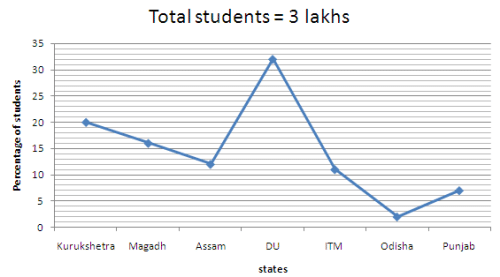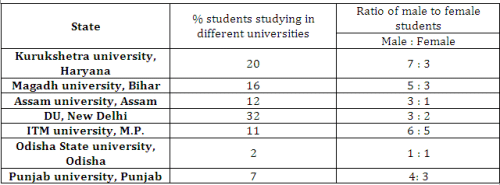Quantitative MCQ - 13 - Bank Exams MCQ
30 Questions MCQ Test NABARD Grade A & Grade B Preparation - Quantitative MCQ - 13
Directions (Q.1-5): Study the following graph and table carefully to answer the questions that follow.
Percentage distribution of students studying in different universities of seven states

University wise percentage and ratio of male and female students studying in these universities

What is the total number of male students studying in ITM, Magadh and Panjab universities together?
Directions (Q.1-5): Study the following graph and table carefully to answer the questions that follow.
Percentage distribution of students studying in different universities of seven states

University wise percentage and ratio of male and female students studying in these universities

What is the average number of female students studying in states Odisha and Assam together?
Directions (Q.1-5): Study the following graph and table carefully to answer the questions that follow.
Percentage distribution of students studying in different universities of seven states

University wise percentage and ratio of male and female students studying in these universities

The male students studying in Kurukshetra university are approximately what percent of male students studying in DU?
Directions (Q.1-5): Study the following graph and table carefully to answer the questions that follow.
Percentage distribution of students studying in different universities of seven states
University wise percentage and ratio of male and female students studying in these universities
Find the difference between no. of male students studying in universities of M.P and Assam together and no. of female students studying in universities of Bihar and New Delhi together?
Directions (Q.1-5): Study the following graph and table carefully to answer the questions that follow.
Percentage distribution of students studying in different universities of seven states
University wise percentage and ratio of male and female students studying in these universities
Female students studying in the Kurukshetra University of Haryana are what percent (approximate) of total students studying in Magadh university of Bihar?
Directions (6-10): What should come in place of the question mark (?) in the following series?
177, 170, 159, 146, ? , 110
Directions (6-10): What should come in place of the question mark (?) in the following series?
2, 3, 11, 38, ? , 227
Directions (6-10): What should come in place of the question mark (?) in the following series?
7, 17, 54, ?, 1098, 6591
Directions (6-10): What should come in place of the question mark (?) in the following series?
55, 109, ? , 433, 865, 1729
Directions (6-10): What should come in place of the question mark (?) in the following series?
1/2, 1, 1 1/2, 2, 2 1/2, 3, ?
P and Q started a business by investing Rs. 45,000 and Rs.54,000 respectively. After four months R joined the business with a capital of Rs. 30,000. After two more months Q left the business with his capital. At the end of the year P got a share of Rs. 13,500 in the profit. What is the total profit earned?
The simple interest accrued on a sum of certain principal is Rs. 7,200 in six years at the rate of 12 p.c.p.a. What would be the compound interest accrued on that principal at the rate of 5 p.c.p.a. in 2 years?
If the numerator of a fraction is increased by 300% and the denominator is increased by 100%. The resultant fraction is 1 11/19. What was the original fraction ?
At present, Meena is eight times her daughter’s age. Eight years from now, the ratio of the ages of Meena and her daughter will be 10 : 3 respectively. What is Meena’s present age ?
An amount of money is to be divided among A, B and C in the ratio of 3 : 5 : 7 respectively. If the amount received by C is Rs. 4,000 more than the amount received by B, what will be the total amount received by A and B together ?
Directions (16-20): Given below is the table which shows the 5 products sold by a manufacturer, % discount offered on marked price and % profit earned on cost price.
What is the ratio of Marked price and cost price of article B.
Directions (16-20): Given below is the table which shows the 5 products sold by a manufacturer, % discount offered on marked price and % profit earned on cost price.
If total profit on selling 5 units of E type product is 210 then find the marked price per unit of article E.
If cost price of product A and D is same then find the ratio of marked price of product A to the marked price of product D.
Directions (16-20): Given below is the table which shows the 5 products sold by a manufacturer, % discount offered on marked price and % profit earned on cost price.
If marked price of article A is 180 then find the cost price of article A.
Percentage of profit earned on product E is what percent more than percentage of profit earned on product B.
Directions (21-25): In the following number series only one number is wrong. Find out the wrong number.
7, 12, 40, 222, 1742, 17390, 208608
Directions (21-25): In the following number series only one number is wrong. Find out the wrong number.
6, 91, 584, 2935, 11756, 35277, 70558
Directions (21-25): In the following number series only one number is wrong. Find out the wrong number.
9050, 5675, 3478, 2147, 1418, 1077, 950
Directions (21-25): In the following number series only one number is wrong. Find out the wrong number.
1, 4, 25, 256, 3125, 46656, 823543
The average age of a group of 14 persons is 27 years and 9 months. Two persons, each 42 years old, left the group. What will be the average age of the remaining persons in the group?
The ratio of milk and water in 55 litres of adulterated milk is 7 : 4. How much water must be added to make the mixture’s ratio 7 : 6?
A milkman defrauds by means of a false measure to the tune of 20% in buying and also defrauds to the tune of 25% in selling. Find his overall % gain if he proffesses to sell the milk at cost price.
The difference between the simple interest received from two different sources on Rs 1500 for 3 years is Rs 13.50. The difference between their rates of interest is :
A man borrows Rs 6000 at 10% rate of interest compounded annually. He pays back Rs 2000 at the end of each year to clear his debt. The amount that he should pay to clear all his dues at the end of third year is
|
870 videos|1431 docs|435 tests
|














